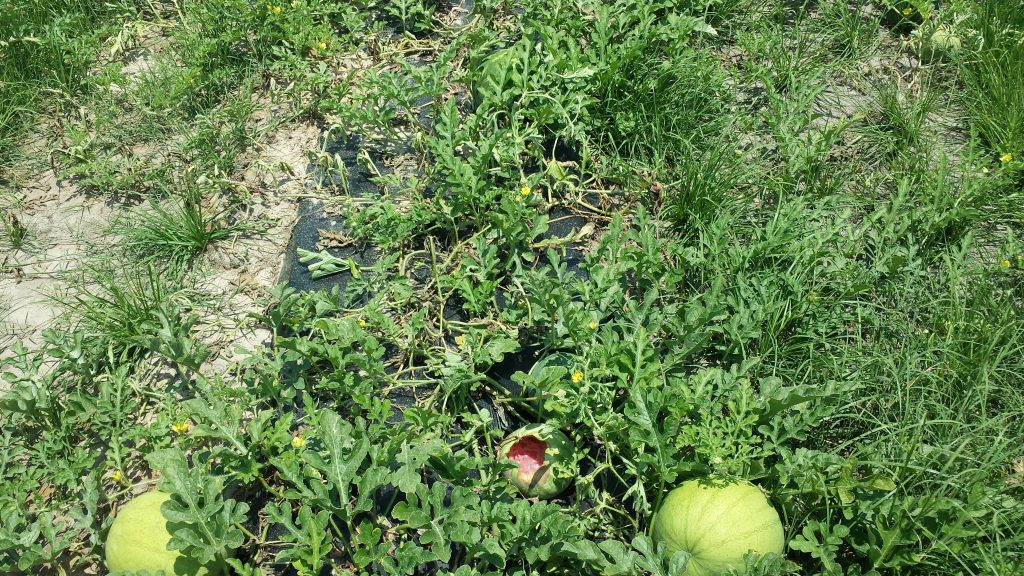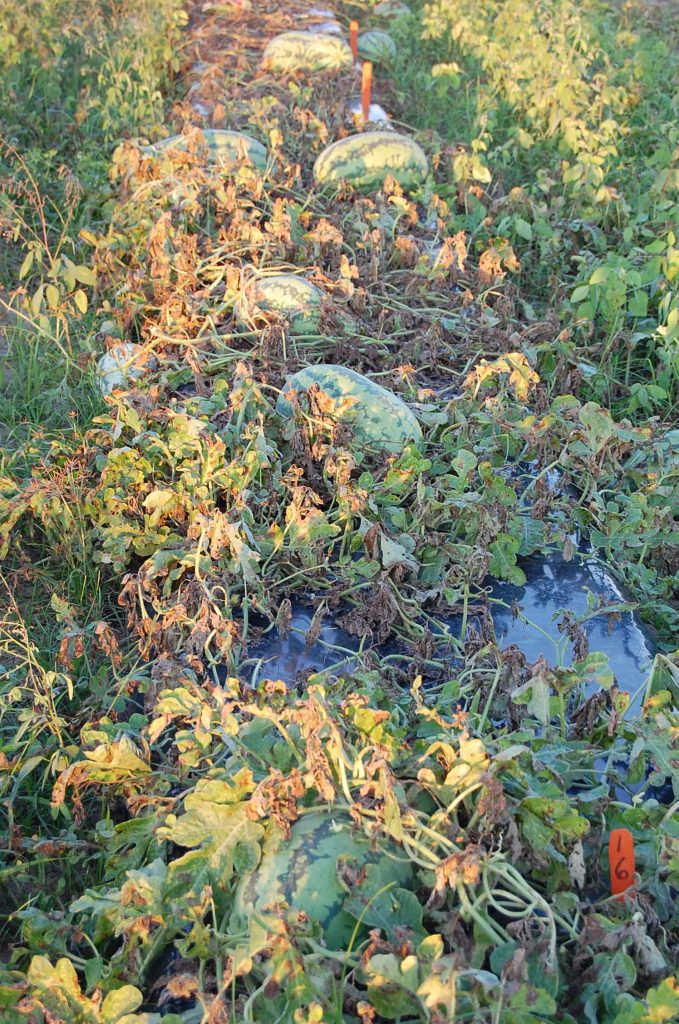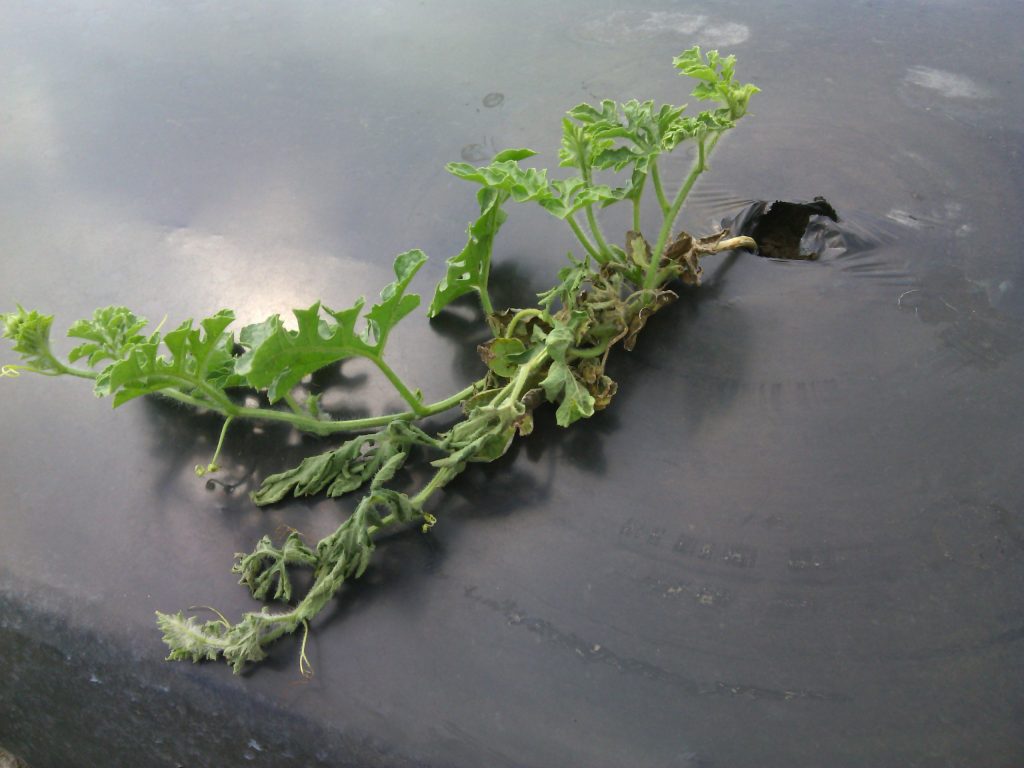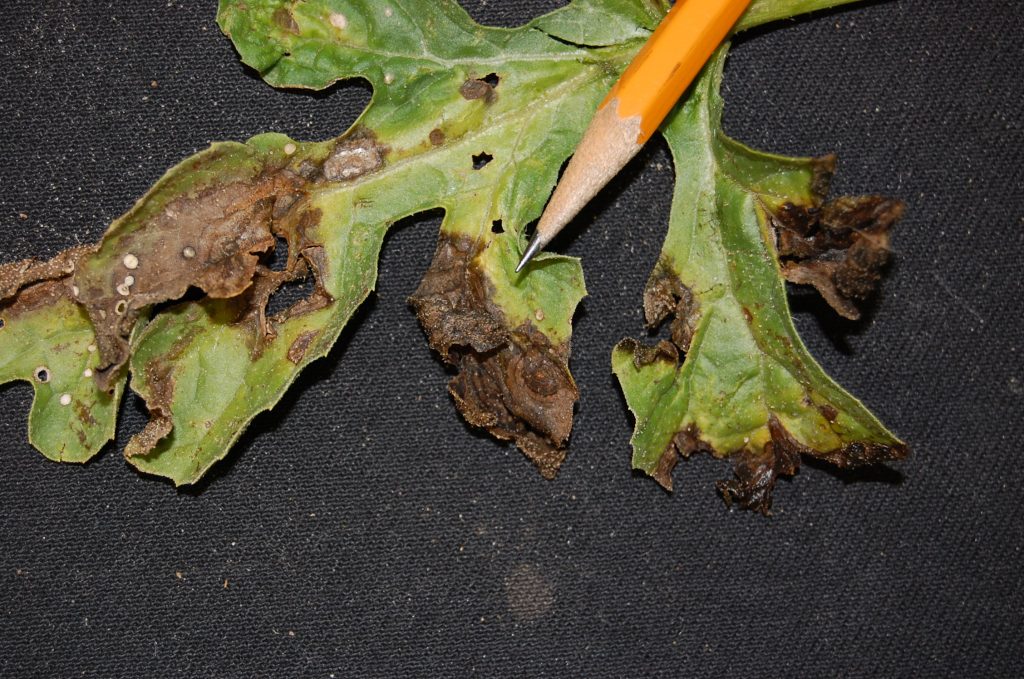By Nicholas S. Dufault
Gummy stem blight (GSB) and fusarium wilt (FW) can be common problems for watermelon producers in the Southeast. These two diseases are caused by fungal pathogens from the same taxonomic subphylum, but that is where the similarities end. GSB tends to be more of a foliar pathogen that can move to the petioles and vines, and in extreme cases, the melons. FW is confined to the soil and only affects the plant’s vascular tissue. Because of these differences, the management of these pathogens tends to vary.

HOST RANGE
GSB and FW disease
management starts with understanding the pathogen. GSB has a large cucurbit
host range causing damage on watermelon, cantaloupe, cucumber, pumpkin, squash,
muskmelon and other melons.
FW, on the other hand, has a host range limited to watermelon. However, there are different types of this pathogen that can infect squash, cucumbers and other melons, but these types do not infect watermelon and vice versa. This is one reason why grafting with squash or other cucurbit rootstocks can nearly eliminate FW, but it will not have the same effects on GSB.
LIMIT INOCULUM
Any watermelon disease management program starts by having healthy seed and
plants. This will help eliminate inoculum, pathogen parts capable of causing
infection, and thus limit the impact any one disease has on production.
Another means to limiting inoculum is through crop rotation and reduction of organic debris that may support the pathogen’s survival. For FW, these are critical steps to reducing the overall disease impact. With GSB, they are critical, but GSB’s impact can still be devastating under the right conditions. Thus, integrating management techniques is necessary when trying to control watermelon diseases.
IDENTIFICATION IS IMPORTANT
Pathogen/disease
identification is another important factor for determining which strategies to
use in a management program. FW infects the vascular tissue, causing wilting
and eventually complete plant collapse before fruit set. Symptoms are typically
first observed on one side of the plant, but sudden plant collapse without
wilting is possible. Once these symptoms are apparent, there is little that can
be done to manage this disease.

GSB, on the other hand, can infect all plant parts. Typically, light to dark-brown spots are observed on the leaves for this disease. Lesions, localized disease areas or wounds, can also form on watermelon stems and petioles that crack and are often accompanied by “gummy ooze.” While this is not a diagnostic trait of the disease, it is responsible for its namesake. GSB is typically identified by the presence of fungal structures, called pycnidia, in these lesions and spots.
Wilting, followed by death, can occur in severe GSB outbreaks. It is possible to manage GSB after the disease is present, especially if it is done early in the epidemic before plants begin to collapse.
MAKING MANAGEMENT DECISIONS
Fusarium Wilt
As previously mentioned, once FW symptoms appear in the field, there is very
little that can be done for this disease. The best thing is to monitor disease presence
and record this information for future management decisions.
The most efficacious FW management programs start before planting/transplanting, and multiple options are available. Some of these include fumigants, grafting, cultivar selection and delayed planting/transplanting date. All these strategies are effective at managing FW, however, the return on investment from these strategies if often dependent on disease prevalence.

There are other factors to consider as well when implementing these strategies. For example, delaying the planting date will ultimately delay the harvest dates. It is possible that this delay could lead to crop sales under reduced watermelon prices compared to earlier planting dates. So, weighing the losses from FW compared to the possibility of reduced returns needs to be considered for this strategy. There is no one perfect strategy for FW control, but it may be possible to find the greatest returns by integrating these strategies rather than relying on only one.
Gummy Stem Blight
Once GSB appears in
a field, there are biological and chemical products available that can assist
with disease control. Product application timing is critical for control. Often,
more efficacious management is seen when using products preventively.
Fungicides have proven to be effective for GSB management. Contact fungicides (e.g., products with the active ingredients chlorothalonil and mancozeb) are effective, especially when applied just before or after disease detection. There are many other fungicides available for GSB control, and some provide better control than contact fungicides after infection. However, due to fungicide resistance, it is critical to not use these site-specific fungicides alone, especially those in the Fungicide Resistance Action Committee groups 11 and 7.

SUMMARY
Fusarium wilt and gummy
stem blight of watermelon continue to be problems for many producers in Florida
and the United States. Fortunately, there are many effective management
strategies available for these two distinct diseases.
Planning for these diseases starts before planting, especially for FW, with monitoring and identification being critical components. There is, unfortunately, no one guaranteed technique when it comes to disease management. However, integrating multiple strategies should provide sustainable and beneficial control for these devastating diseases.
Nicholas S. Dufault is an associate professor at the University of Florida in Gainesville.
This article was featured in the June issue of VSCNews magazine. To receive future issues of VSCNews magazine, click here.
Share this Post









